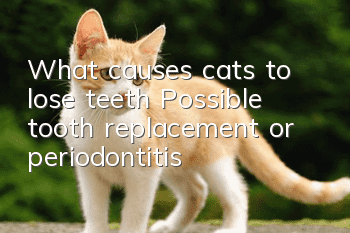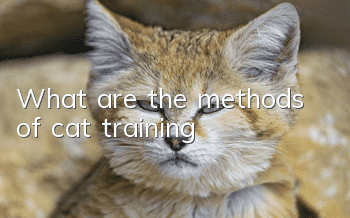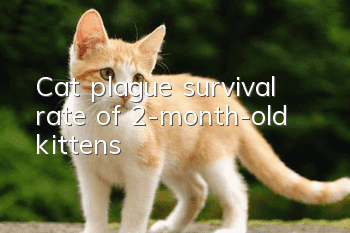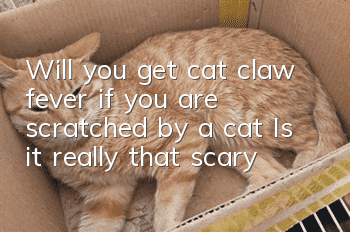What causes cats to lose teeth? Possible tooth replacement or periodontitis

Healthy cats always have a pair of white teeth, and we can often experience the power of cat teeth personally. However, sometimes we also pick up some strange things on the floor of the room, such as cat teeth. This means that the cat has lost teeth. Teeth loss may be caused by many reasons, including ordinary tooth replacement or oral disease.
1. Changing teeth
Cats begin to grow teeth roughly 2 weeks after birth, and all 26 teeth will grow in about 1 month. Baby teeth fall out around 3 months after birth, and all 30 new teeth have grown in between 5 and 6 months old.
Starting from the fifth month after birth, cats begin to replace their canine teeth. At this time, when you open the cat’s mouth, you can often see that the gums of the cat’s canine teeth are slightly red. This is a sign that new teeth are about to grow. After a week or two, you will see four canine teeth on the cat's upper or lower jaw, that is, there are two teeth at the same canine position, one is slightly larger, and these are the newly grown teeth. As new teeth grow, the primary canine teeth are slowly loosened, fallen off, and spit out by the cat. If you observe carefully, you may pick up the cat’s baby teeth. Keeping the cat’s deciduous teeth can also be regarded as a kind of souvenir!
When a cat is four or five months old, it may have a loss of appetite during the teething stage. At this time, on the one hand, you need to pay attention to the growth of the teeth in the cat’s mouth, and on the other hand, you need to provide it with easy-to-chew food. To protect new teeth.
One year after a kitten is born, the incisors on the lower jaw begin to wear out, and after seven years, the canine teeth gradually age. In the seventh year, the incisors of the lower jaw are ground into a round shape; in a ten-year-old cat, all the incisors of the upper jaw are gone. Careful cat owners, by observing the changes in their cats’ teeth, should prepare different foods for their cats to benefit their cats’ health.
2. Periodontitis
Dental diseases such as periodontitis can lead to tooth loss. Periodontitis causes the tissue cells that support teeth to be destroyed, causing teeth to loosen and fall out. Because periodontitis is accompanied by severe pain, it hates things touching its mouth and refuses to eat.
If the symptoms worsen, osteomyelitis will appear in the jaw bone, and pus from the root of the tooth will break out. Once this happens, it is necessary to receive specialized treatment as early as possible, so take it to the hospital as soon as possible. The first step in treatment is to control the infection. Penicillin 50,000 units/kg body weight and dexamethasone 0.5 mg/kg body weight can be mixed once for intramuscular injection, twice a day. Gentamicin 10,000 units/kg body weight, dexamethasone 0.5 mg/kg body weight, mixed once for intramuscular injection, 2 times/day. The second step is supportive therapy. For cats with reduced appetite, glucose and compound saline should be infused intravenously, and oral vitamin B preparations should be given.
In addition, when kittens change their teeth 3 months after birth or when they are young,When we are old, teeth will fall out even if there is no disease.
3. Aging
The gums and alveoli of 12 to 13-year-old cats begin to relax, and teeth will fall out. It's not sick at this point, so there's nothing to worry about, but it's not chewing food as well anymore. At this time, you can no longer feed it the food it ate when it was young, but change it to food that is easy to digest and chew.
When an elderly cat loses its teeth, first check whether it has oral disease and whether the tooth loss is caused by oral disease. If so, it is necessary to see a dentist and have your teeth cleaned and tartar removed. If not, it is usually caused by the decline in physical function of older cats. The teeth of cats that are old enough also begin to age and slowly fall out.
In addition, dental diseases are mostly caused by bacterial infection, so preventing the production of tartar or tartar is the first step in prevention. Observe the condition of your mouth more often and treat your teeth with a toothbrush or gauze. It is good for the health of cats’ teeth and oral cavity.
- What should I do if my kitten always bites people?
- How to train a cat to be obedient?
- What are the types of cat anthelmintics? Common types of cat anthelmintics!
- What are the symptoms of a cat overeating? What should I do if my cat is full?
- Why do Persian cats have different eye colors?
- Do Siamese cats have yellow eyes? What kind of Siamese cat does your family have?
- Signs that a cat is hungry
- Why is Garfield so picky about food?
- What are the symptoms of depression in cats?
- Is it good to neuter female cats? Things to note when neutering female cats!



